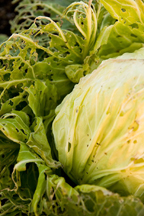 |
The Bay Gardener
By Dr. Frank Gouin
|
Start Now to Eat Well in Autumn
Cool-weather coles thrive with a head start in summer
If you like fresh broccoli, cabbage, Chinese cabbage, cauliflower, collard greens and kohlrabi, now is the time to sow their seeds.
These are considered cole (as in slaw, from the family Brassica), but think cold crops because their seeds germinate best at temperatures below 70 degrees. Most of the cole crops are rich in sulfur-rich compounds and anti-oxidants, which make them healthful. Cole crops are cool-season vegetables because they grow best under cool weather and are relatively cold hardy. Except for cauliflower and broccoli, all have to undergo extensive chilling before they can flower.
These hot days, you’ll get the best germination in a cool basement or in air conditioning.
Choose a commercial seed-starting medium, or prepare your own by blending together equal parts by volume of fine-shredded peat moss and No. 2 grade perlite or vermiculite. To each six-inch pot of medium add one tablespoon of dolomitic limestone and one-half teaspoon of 10-6-4 or 10-10-10 fertilizer.
An even better propagation mix blends one part by volume LeafGro or Chesapeake Green compost with two parts by volume peat moss. You do not need to add any fertilizer or lime to this compost-base mix.
In sowing small volumes of seeds, I like using two-and-one-half-inch square flower pots with ample drainage holes in the bottom. Fill the pots to within one-half inch from the top and uniformly scatter a dozen or so seeds over the surface. Sprinkle sufficient play sand over the seeds to cover them. Water carefully. Most cole crop seeds will germinate in five to 10 days.
As the seeds germinate, place them in full sun. Don’t wait until all of the seeds have developed leaves before moving them into the full sun. Leaves can scorch when plants are moved from low-light intensity to full sun in summer.
The first leaves to appear are not true leaves but cotyledons. Your seedlings are not ready to transplant until you can see small young leaves emerging from between the cotyledons. Allow the seedlings to grow for one to two weeks before transplanting them into larger containers of three or four inches. The compost-amended medium used for seeding also makes an excellent growing medium.
If you wish to save time and if you have adequate space, try direct seeding into three- or four-inch pots. Direct seeding eliminates transplant shock. Sow at least two seeds in each larger pot. After the seeds have germinated, use nail clippers to cut out all but one seedling in each pot.
The plants should grow in the containers they are seeded in until they are sufficiently large for planting in the garden. Add water as needed and liquid fertilizer every two weeks — unless you’ve made a compost-based medium, which needs not fertilizer.
Cut that Tree!
Q Thank you very much for the reply about my cherry tree [Vol. xiv, no. 28: July 13]. I’m not surprised that you think it should be removed. I dread doing it, as it’s a nice tree otherwise.
—Lisa Petersen, Owings
A Do it now before you regret not having done it two years from now.
Ask Dr. Gouin your questions at [email protected]. All questions will appear in Bay Weekly. Please include your name and address.